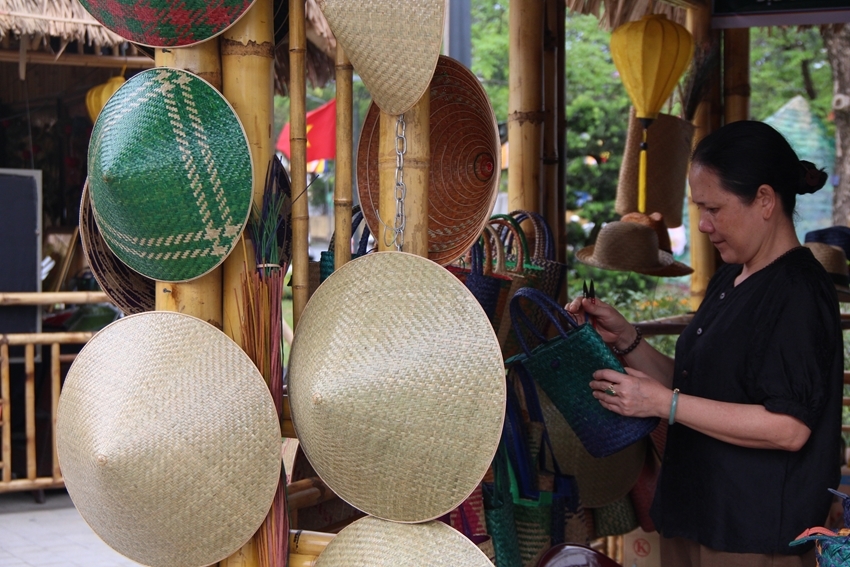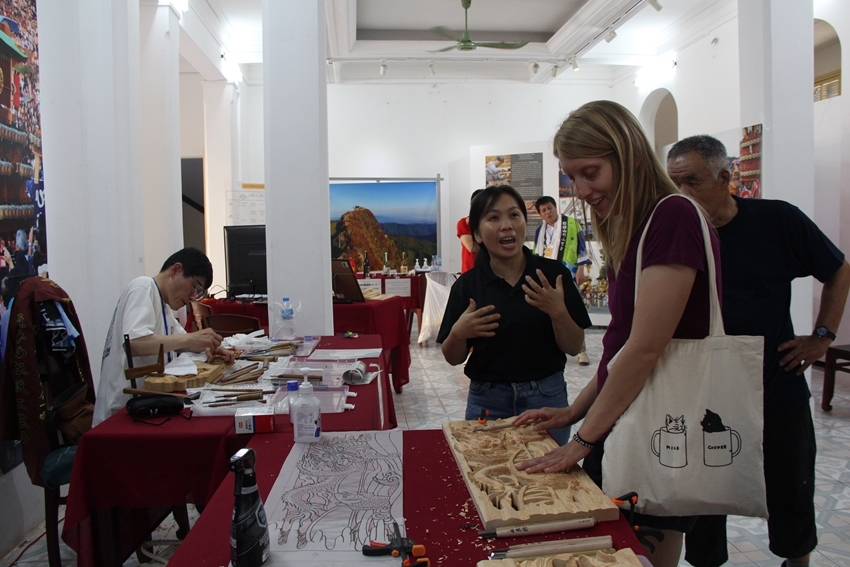    |
 |
| Products of Hue’s craft villages attracting tourists’ interest |
At Nguyen Dinh Chieu walking street and the neighboring park along the Huong River, tourists flock here to experience the uniqueness made by artisans coming from all regions of the country who gathered at Hue Traditional Craft Festival 2023.
The famous traditional craft villages of the Ancient Capital and those of localities from the South to the North, or, of Japan and Korea seemed to “treat” tourists “cultural dishes” that are not always available to enjoy.
Along Nguyen Dinh Chieu walking street, in the bamboo stalls, artisans from each craft village displayed and performed the quintessence of crafts that they have handed down and promoted for generations.
With various products from silk, pottery, weaving, hat making, and bamboo handicrafts, etc., of nearly 70 craft villages, Hue still occupied the majority and reached the attention of locals and tourists.
While coddling each ceramic vase of the famous pottery village of Phuoc Tich, Mr. Nguyen Tue Hung (a tourist from Da Nang) couldn’t help praising about how the villagers could keep and bring unique products to the market. With a passion for pottery and collecting many pottery products, according to Mr. Hung, it was challenging to make a comparison between Phuoc Tich and other ceramic villages all over the country as the pottery of the ancient village by the O Lau River still had its “position”.
“Phuoc Tich pottery is not only beautiful but also meets the market’s demand. More importantly, the villagers still keep their handicraft, promote and put their products into market in the context of modernization and fierce competition,” Mr. Hung assessed after choosing to buy some Phuoc Tich pottery products.
A few dozen meters away was the stall displaying Hue conical hats which were always in crowds by tourists. People came here watching with concentration the process of making a conical hat, which they have rarely seen. Some people also waited to buy the conical hats right after the artisan finished the last step.
“Hue is a land of conical hats. I’ve heard a lot about it before. However, this is the first time that I’ve seen the performance of the artisans about how to make conical hats by my eyes. It is thought to be simple but is very sophisticated in fact,” shared Mrs. Hoai Thu (a tourist from Quang Binh).
    |
 |
| Foreign tourists were excited to learn about the art space of Danjiri wooden float sculpture of artisans from Saijo City (Japan) |
The most crowded time of tourists flocking to the exhibition space was late afternoon and night. Together with Hue craft villages, other well-known craft villages were also attractive and captivating those setting foot to the space of craft villages in this Festival. Its attractiveness was even higher with the participation of the artisans coming from Gongju and Namyangju cities of Korea, and the cities of Saijo, Shizuoka, Takayama, and Sasayama (Japan).
The artisans took the quintessence of craft village of their hometown, together with their own unique products to Hue City to perform to Vietnamese friends as a way to exchange culture and share their experiences in the preservation of craft village.
One of the spaces getting most interest was the art space of Danjiri wooden float sculpture of the artisans coming from Saijo city of Japan. In this space, the artisans showed off their skills of wooden carving with extremely special woodworking techniques.
The artisans of this craft village also brought the wooden float with dragon carved patterns for actual display, bringing viewers lost in the wonderful world of carving. More interestingly, tourists coming to this art space also received the guideline of the artisans to experience the process of carving on wooden panels along with the introduction of the carved images.
With over 10 minutes “incarnating as an artisan”, Nguyen Vu (from Hue City) was excited although he was sweated after struggling with the tools to chisel and hewn the wooden panel. “Although it is just an experience, it helps me know more about their manipulation, their love with the craft, as well as the cultural beauty that Saijo people in particular and Japanese people in general have tried to preserve and promote their traditions,” shared Vu.
Just like that, going from one craft village to another, tourists would get a chance to find out many novel and interesting things. The quintessence of craft villages is not a place to show off the quintessence; it is an opportunity to promote and help the public known more about the lives of the craft villages erstwhile up to now.